
By CoinWeek …..
Heritage Auctions‘ Long Beach sale of rare coins and medals realized $18.095 million and included a number of highlight coins – including the surprising offering of the Mickley-Hawn-Queller specimen 1804 dollar.
We have looked through the results and compiled a list of the seven coins that make up the Top 5 highest prices paid. In this list you will read an excerpt from the Heritage Auctions’ catalog, known provenance information, and notes put together by CoinWeek’s editors.
Obviously, coins in the upper strata of the rare coin market can be acquired or traded only by the mega-wealthy or the industry’s top dealers, but the prices that the hobby’s most coveted coins realize do provide valuable insight into the relative health and liquidity of the rare coin marketplace.
Note: Coin illustrations are taken from Heritage’s online catalog. All listed prices realized include the 20% buyer premium added to the final hammer price, which represents what the buyer actually paid.
5 – (tied) $336,000
1794 B-1, BB-11 Silver Dollar, PCGS XF40 CAC
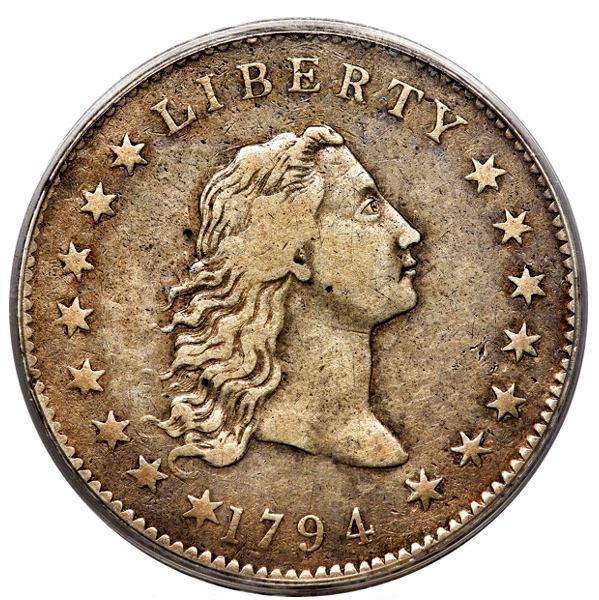 In his survey of 1794 silver dollars, Martin Logies enumerated 134 surviving examples, and we know of two new examples that were not recorded in his reference, bringing the total to 136 pieces, for a survival rate of 7.7% of the mintage.
In his survey of 1794 silver dollars, Martin Logies enumerated 134 surviving examples, and we know of two new examples that were not recorded in his reference, bringing the total to 136 pieces, for a survival rate of 7.7% of the mintage.
Logies accounts for six Mint State examples, 12 AU representatives (including four that are cleaned or tooled), another dozen XF45 pieces, and 10 problem-free XF40 examples including the present piece. Nearly all of those 30 top-grade examples are housed in collections ranging from type sets to specialized die variety cabinets, with few opportunities to bid on such examples.
Ex: Upper Midwest Coin Collectors Convention (Leo Young, 6/1957), lot 1333; California State Numismatic Association Convention (Leo Young, 4/1958), lot 1507; American Numismatic Association Convention (Leo Young, 8/1959), lot 1647; Corrado Romano; Romano Estate (Stack’s, 6/1987), lot 741; Four Landmark Collections (Bowers and Merena, 3/1989), lot 1933; private collector (Gerard Menicucci, 2004, per Martin Logies).
NOTES – This 1794 dollar variety trades so infrequently that each reported sale of a coin serves as a snapshot in time for where the rare coin market is at any given point. Based solely on predictive measures, the $336,000 that this example brought is quite strong, surpassing the $305,500 that a PCGS example in an Old Green Holder realized in 2014, before the market dipped in 2015.
Our internal survey of CAC prices shows in 2018, shows coins with the green bean have more-or-less maintained position, despite the overall decline in the market, with rare coins and conditionally rare coins in highly collectible series, making significant gains. This is the sole XF40 example to earn a CAC sticker, with 13 finer specimens, including four in Mint State.
The price realized is about what we have come to expect the market to bear for a rarity of this caliber with CAC approval.
5 – (tied) $336,000
1870 Type Two Twenty, NGC PR65 Ultra Cameo CAC
 The 1870 proof Liberty double eagle had an impressively low mintage of 35 pieces, a minuscule production total in absolute terms, but not unusually small in the context of the Type Two series.
The 1870 proof Liberty double eagle had an impressively low mintage of 35 pieces, a minuscule production total in absolute terms, but not unusually small in the context of the Type Two series.
Distribution seems to have been remarkably low and some of the coins may have been melted as unsold after the close of the year. PCGS CoinFacts estimates that 8-12 pieces are extant today; however, when one subtracts the number of institutionally held examples of this date, the actual number available to private collectors appears to number only five or six specimens.
This is an unusually low number of survivors for proof gold, indicating several pieces were most likely dropped into circulation because of their high face value when the original owners, or their heirs, encountered hard economic times. The most complete roster we have been able to assemble accounts for nine examples with a few earlier citations that may, or may not, represent the coins in the main roster
NOTES – A true rarity from a series that stockpiles hard-to-acquire coins. The coin collecting hobby in America was minuscule in 1870, and only a handful of well-heeled collectors could afford to set aside Proof examples of America’s gold coins, especially denominations as valuable as the double eagle.
Heritage points out the issue’s high attrition rate, but what must be noted when evaluating the hammer price is how infrequently this issue is traded. CAC has approved four examples in grades PR64 and above. PCGS has not certified a single example in a gem grade with any degree of cameo frost.
By our estimation, this coin is tied for the second or third finest known. An NGC example graded PF67UCAM brought $503,100 at a 2013 Bonham’s sale. That coin is the plate coin for the issue on NGC’s website.
5 – (tied) $336,000
1804 B-1 Bust Quarter, NGC MS65 – The Finest Certified
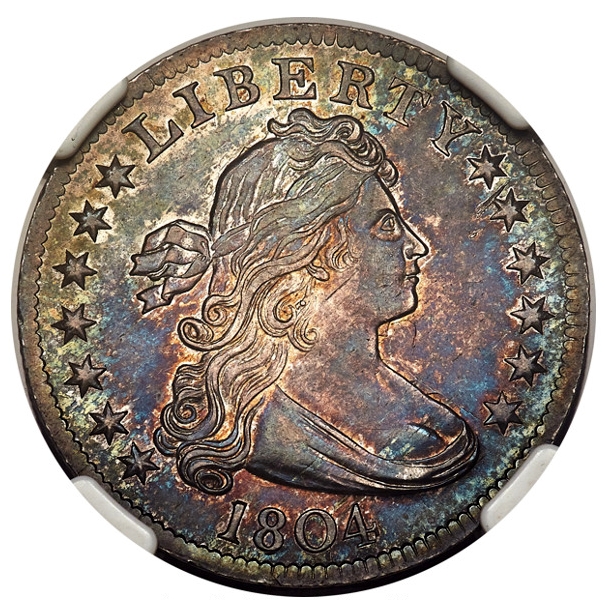 This wonderful coin, also pedigreed to the Col. Green collection of early quarters, is the Browning-1 variety, with the 4 in the date low and a die cut between stars 8 and 9, as seen on all examples. Although not as famous (because neither a single-year type nor a first year of issue) as the 1796 quarters, the 1804 quarters are many times rarer in Mint State than the 1796 pieces.
This wonderful coin, also pedigreed to the Col. Green collection of early quarters, is the Browning-1 variety, with the 4 in the date low and a die cut between stars 8 and 9, as seen on all examples. Although not as famous (because neither a single-year type nor a first year of issue) as the 1796 quarters, the 1804 quarters are many times rarer in Mint State than the 1796 pieces.
In the 1975 ANA sale, the cataloger wrote in part of this coin:
“Extremely rare grade and one of two finest known of just three, possibly four known in full Mint State. Certainly the most famous specimen and long thought to be clearly the finest.”
As of (5/18) NGC has certified 38 Mint State 1796 quarters, compared with only five Mint State 1804s, of which this stands alone as the finest by two grade points. At PCGS, there are 37 Mint State 1796 quarters, compared with only eight Mint State 1804s. This is the single finest 1804 quarter certified at either NGC or PCGS. This is a monumental early Bust quarter, a coin whose rarity, historicity, and numismatic importance simply cannot be overstated.
Ex: Col. E.H.R. Green; Stack’s (1945); Jerome Kern Collection (B. Max Mehl, 1950), lot 1385; Eugene Gardner Collection (Stack’s, 2/1965), lot 1620; H. Philip Speir estate (Stack’s, 3/1974), lot 2, which brought $16,500; ANA Sale (Superior, 8/1975), lot 352; Central States Signature (Heritage, 4/2008), lot 2274; Joseph C. Thomas Collection, Part Two / FUN Signature (Heritage, 1/2011), lot 5507.
NOTES – There were two prior sales of this exact coin by Heritage: Auction 1151, Lot 5507 Sunday, January 9, 2011 for $345,000 and Auction 1104, Lot 2274 Saturday, April 19, 2008 for $310,000.
The 2018 price realized of $336K is well within the zone of what you would expect this coin to bring in today’s market. The slight appreciation that we see in price realized is partially explained by the increase in buyer’s premium charged by the auction houses.
Given that the market for non-CAC classic coins has fallen dramatically since 2015, this is a solid price point for this coin.
4 – $396,000
1796 $2 1/2 No Stars on Obverse, BD-2, R.4, MS61 PCGS. CAC
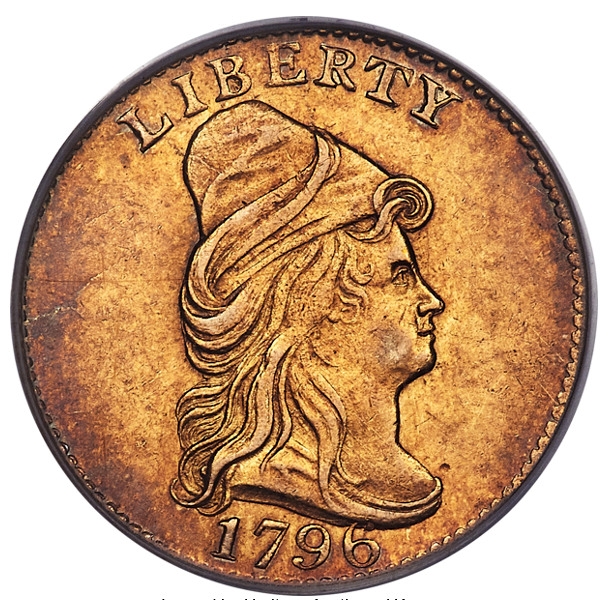 The 1796 No Stars quarter eagle is the only 18th-century American gold or silver coin issue that lacks stars within the obverse rim. The lack of stars makes the coin extremely appealing to collectors, both aesthetically and because it marks a one-year type. Why were there no 1795 No Stars half eagles, the first year of that denomination? No answer is readily forthcoming.
The 1796 No Stars quarter eagle is the only 18th-century American gold or silver coin issue that lacks stars within the obverse rim. The lack of stars makes the coin extremely appealing to collectors, both aesthetically and because it marks a one-year type. Why were there no 1795 No Stars half eagles, the first year of that denomination? No answer is readily forthcoming.
The lack of stars gives the obverse design an unusual appeal in the cameo appearance of the right-facing, turbaned Liberty occupying the center with the broad, open fields surrounding her on either side.
The present 1796 No Stars quarter eagle is of the BD-2 variety, showing the Normal Arrows reverse, with a noticeable “lump break” above the tip of the eagle’s right (facing) wing. This piece is absolutely Mint State, with full luster throughout. Moreover, it possesses that marvelous “original skin” or “crusty gold” look of early, unfooled-with U.S. gold coins.
Population: 3 in 61, 3 finer. CAC: 3 in 61, 3 finer (5/18).
Ex: Chicago Signature (Heritage, 8/2011), lot 7436, realized $276,000.
NOTES – This coin is a outstanding example for the grade and the price realized is indicative of the premium that we’ve come to expect for CAC-approved coins with “original skin”.
Many early US gold coins have been processed to “beautify” them in the eyes of potential buyers. As a result, the available pool of original coins in high states of preservation is getting constantly smaller and smaller.
The price realized for this example is good news for collectors who specialize in this area. Early gold is resilient, rare, and increasingly held dear to the most serious and affluent collectors in the United States.
3 – $444,000
1776 EG FECIT Pewter Dollar, MS67 Finest Known Continental Dollar
 The 1776 Continental dollar is an enigmatic, complex issue that has fascinated numismatists for more than 200 years.
The 1776 Continental dollar is an enigmatic, complex issue that has fascinated numismatists for more than 200 years.
No official documentation on the striking of these coins has ever come to light. Numismatic scholars from Sylvester Sage Crosby to Eric P. Newman and Michael Hodder studied the issue in detail, mapping out a convincing theory of the origin and purpose of the coins and classifying the numerous varieties that surfaced over the years.
Recently, exciting discoveries by authors like Eric Goldstein and David McCarthy have raised questions about the fundamental nature of these coins and their place of origin. The new evidence is certainly thought provoking, but we suspect the last word on the Continental dollar has yet to be heard.
Ex: Virgil Brand; F.C.C. Boyd; John J. Ford (Stack’s, 10/2003), lot 8; FUN Signature Auction 1166 (Heritage, January 8, 2012), lot 3006, where it realized $546,250.
NOTES – Price guide valuations for this series and this coin in particular are almost non-existent.
Being the finest-graded example of an enigmatic issue puts the piece in an uncertain spot in the marketplace. If McCarthy and Goldstein’s research, which greatly diminishes the coin’s connection to the Continental Congress, is correct, then expect to see a continued slide in price and interest.
As it stands, the valuation of this specimen has dropped by about 1/5th, off $100,000 from the price it brought six years ago.
2 – $999,000
1793 With Periods Chain Cent, MS65 Brown PCGS CAC
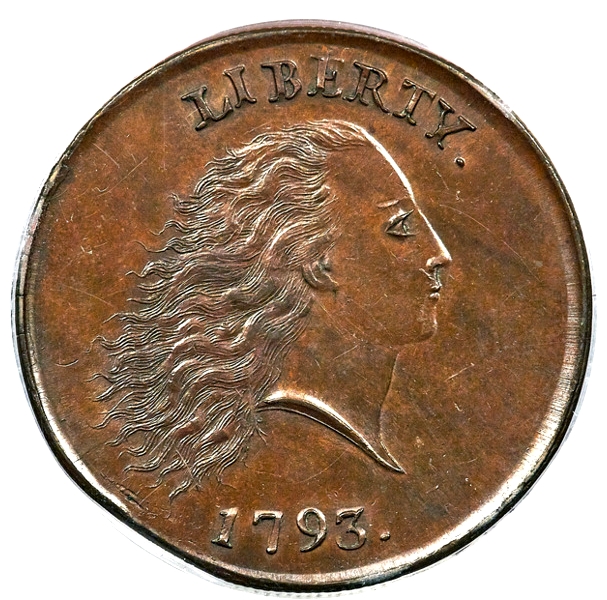 The plate coin in Walter Breen’s Encyclopedia of Early United States Cents 1793-1814. The Chain cents were the first actual United States coins minted at the Philadelphia Mint in March 1793. These coins are the very first federal type coins, minted before the 1793 half cents, or the other large cent designs. Mint records identify a total mintage of 36,103 Chain cents were delivered March 1 through March 12, 1793.
The plate coin in Walter Breen’s Encyclopedia of Early United States Cents 1793-1814. The Chain cents were the first actual United States coins minted at the Philadelphia Mint in March 1793. These coins are the very first federal type coins, minted before the 1793 half cents, or the other large cent designs. Mint records identify a total mintage of 36,103 Chain cents were delivered March 1 through March 12, 1793.
The obverse of the S-4 Chain Periods cent is unlike earlier Chain cent varieties. The hair shows a different treatment, and the periods that follow the date and LIBERTY are unprecedented among all 1793 cents. Walter Breen made the reasonable suggestion that a different engraver prepared this obverse. The periods are similar to Joseph Wright’s 1792 pattern quarters, and led Breen to suggest that Wright engraved this die. Harry Salyards suggested that the engraver of this die continued to prepare the Wreath cent obverse dies. The identification of engravers of the 1793 cents and half cents remains a perplexing numismatic mystery.
Ex: Fifth Semi-Annual Sale (W. Elliot Woodward, 10/1864), lot 603; Joseph Zanoni; Thomas Cleneay (S.H. & H. Chapman, 12/1890), lot 1795; Charles Steigerwalt; John G. Mills (S.H. & H. Chapman, 4/1904), lot 1227; George H. Earle, Jr. (Henry Chapman, 6/1912), lot 3355; Clarence S. Bement (Henry Chapman, 5/1916), lot 286; Col. James W. Ellsworth (3/1923); Wayte Raymond (1923); William Cutler Atwater (B. Max Mehl, 6/1946), lot 10; Louis E. Eliasberg, Sr.; Eliasberg Estate (Bowers and Merena, 5/1996), lot 487; Spectrum Numismatics; American Numismatic Rarities (7/2004), lot 6; FUN Signature (Heritage, 1/2012), lot 3020, where it realized $1,380,000.
NOTES – This exact coin brought $1.38 million six years ago (and that was with substantially lower buyer’s fees). As it stands, this is the consensus third-finest example known, with the two finer examples steeped in pedigree and widespread admiration amongst copper collectors. This piece, with its provenance tracing back to the Civil War, was once held in the most famous US coin collection ever assembled.
There are just a handful of collectors who have both the means and the interest to buy a coin like this. In all likelihood, at $999,000 this coin will prove to be a great buy for the new owner.
1 – $2,640,000
1804 Dollar, PCGS PR62 – The Mickley-Hawn-Queller Specimen
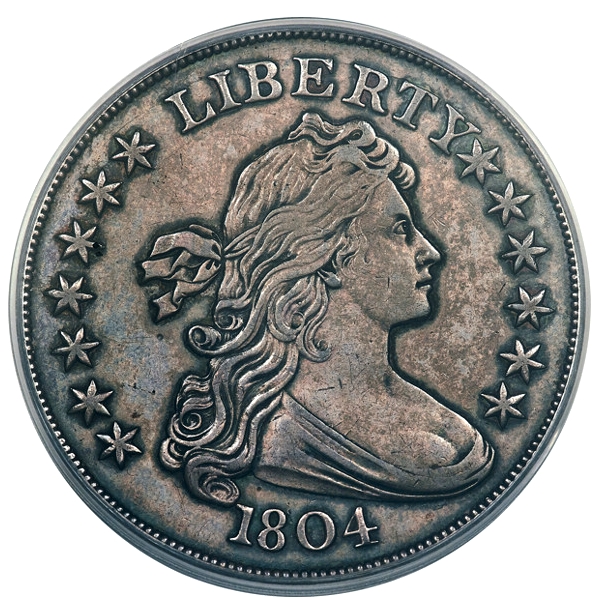 For more than a century, the 1804 dollar has reigned as the “King” of U.S. coinage, a fitting title to bestow on a coin made for royalty. The U.S. Mint received orders to strike complete sets of proof coinage meant to serve as diplomatic gifts for sovereigns such as the Sultan of Muscat, the King of Siam, and the Emperors of Cochin-China and Japan. While most denominations specified by the Mint Act of 1792 were still in production in 1834 and thus simple to produce as proofs, the silver dollar and gold ten dollar (eagle) had not been struck for many years – since 1804, the Mint’s research found. There was just one catch: those silver dollars struck in 1804 were made from carryover obverse dies and did not bear that date. When the Mint struck those silver dollars dated 1804 and a few spares, an inadvertent rarity was created.
For more than a century, the 1804 dollar has reigned as the “King” of U.S. coinage, a fitting title to bestow on a coin made for royalty. The U.S. Mint received orders to strike complete sets of proof coinage meant to serve as diplomatic gifts for sovereigns such as the Sultan of Muscat, the King of Siam, and the Emperors of Cochin-China and Japan. While most denominations specified by the Mint Act of 1792 were still in production in 1834 and thus simple to produce as proofs, the silver dollar and gold ten dollar (eagle) had not been struck for many years – since 1804, the Mint’s research found. There was just one catch: those silver dollars struck in 1804 were made from carryover obverse dies and did not bear that date. When the Mint struck those silver dollars dated 1804 and a few spares, an inadvertent rarity was created.
The Heritage Catalog gives a full chronology and history of this coin and there is no need to repeat it here. You can use the link above to read the full story. Of the 15 know specimens this coin is ranked in the roster as #6. The coin has made 2 prior appearances in Heritage auctions as follows – Auction 1188, Lot 5699 Saturday, August 10, 2013 62 PCGS $3,877,500.00 and Auction 1104, Lot 2089 Saturday, April 19, 2008 62 NGC $3,737,500.00
NOTES – When it was first announced that this 1804 dollar was to be sold at Long Beach, we have to admit that we were a bit surprised. Usually a coin like this gets offered at the Summer ANA or the Winter FUN sale.
The final hammer for this coin was $1,237,500 less than what the coin brought at the summer ANA in 2013, or a little more than a 30% drop in “value”.
Between the 2008 and the 2013 sale the coin was crossed from NGC to PCGS. For whatever reason this was done, there was virtually no change in value by doing so and the slight increase in price realized (about $140K) was roughly equivalent to the increase in auction house buyers’ fee during that five-year period from 2008 to 2013.
We have not asked John Albanese (nor would he say) if the coin had been submitted for CAC approval, but we would assume that this coin did not and would not receive a “green bean”.
Regardless of that, the $2.64 million result is disappointing for such a major rarity. Which begs the question: Does this result tell us anything about the broader market or about the market for “Mega Rarities”?
The last two 1804 dollars that were put up for auction, the Childs coin (finest known, PCGS PR68) and the Dexter coin (PCGS PR65), met with different results. The Childs coin did not sell, despite exceeding what would have been a record price paid for a U.S. coin, according to Stack’s Bowers. The coin, offered for sale by the Pogue family, did not meet the reserve. It was one of only two coins offered by Stack’s Bowers and Sotheby’s that did not sell. The Dexter coin, offered in the final Pogue session, brought an anemic $3.29 million. It was immediately resold for a higher sum (read into that what you will).
Our takeaway is that 1804 dollars have declined in price, especially for examples on the lower end. Sometimes having a coin with a storied history and a historically high price tag isn’t enough. In these instances, quality is especially important. So, too, timing.
For the consignor, these are costly lessons. On the other hand, the new owners may have very well picked up a bargain.




